Are you new to pickleball and wondering what all the fuss is about regarding “volleys”? Or are you a seasoned player looking to up your game? Either way, understanding the ins and outs of this crucial aspect of the sport can make a world of difference in your performance on the court.

In this blog post, we’ll dive into precisely what volleys are in pickleball and why they matter so much. So grab your paddle, get ready to serve, and let’s get started!
What Is a Volley in Pickleball?
A volley in pickleball is a shot where the player hits the ball without letting it bounce. Usually performed at the net after serving or returning the opponent’s shot, volleys can keep opponents on their toes and set up other strategic shots, such as dinks and lobs.
Proper technique is vital for successful volleys; players must use quick footwork and have accurate aim to make shots that won’t give away points. Mastering different types of volleys, such as forehand, backhand, drop, overhead, and lobs, can greatly enhance your overall game. Instead of simply hitting the ball back randomly across the court, utilizing different types of volleys allows you to control where you hit the ball on your opponent’s side.
Punch Volley
One of the more unique volleys in pickleball is the punch volley. This shot is perfect for keeping the ball low and close to the net, especially when an opponent hits a high ball that’s difficult to reach with a standard volley. The punch volley involves hitting the ball with an angled swing, keeping the shot’s trajectory low and close to the ground. This offensive tool allows players to play aggressively at the net without having to leave their feet for every shot.
Roll Volley
The roll volley is another exciting technique in pickleball that involves hitting the ball with an open paddle as it rolls over the net. By returning a shot quickly from an opponent, players can create a fast-paced rally. Mastering the roll volley requires quick reflexes, good hand-eye coordination, and timing. This offensive technique can catch opponents off guard and help score points more quickly.
Drop Volley
Pickleball’s drop volley is a shot that quickly returns the ball, involving keeping the paddle close to the net, making contact as soon as the ball crosses over, and gently dropping it back onto the opponent’s side. This shot can be highly effective, keeping opponents on their toes. It requires good timing, technique, and precision to succeed, but if done well, it can give players a significant advantage during the game.
Dink Volley
Pickleball dink volleys are close-range shots that keep the ball in play and prevent opponents from scoring points. Players softly hit the ball with their paddle, usually just over the net, so it drops barely on their side of the court. This shot can be used defensively to prevent opponents from making winning shots or offensively to set up for another powerful stroke. Mastering the dink volley is essential for competitive pickleball, giving players an edge over their opponents.
Ways to Hit the Volley in Pickleball
Pickleball is a fast-paced game that requires quick reflexes and good strategy to succeed. Hitting the volley can be challenging, but with practice and the proper techniques, you can improve your skills. Here are some tips on how to hit the volley in pickleball:

Ensure Your Feet Are Set
A proper stance will give you more control over your shots and allow you to react quickly to incoming shots. Have one foot slightly forward for balance and ensure both feet are firmly planted on the ground before swinging at the ball.
Keep Your Racket Up
Keeping your racket up as soon as possible after making contact with the ball will help ensure you get enough power behind each shot while giving you more control when returning volleys.
Get Low
Getting down low will help you generate more power behind each shot and make it easier to reach incoming volleys quickly.
Practice Anticipating Where Shots Might Come From
Knowing where an opponent’s shot is likely going can give you an edge when attempting a difficult return volley or when trying to position yourself correctly for your next shot.
Use Spin Correctly
Properly using spin can significantly enhance your ability when hitting volleys. Learning how to use spin correctly can prove helpful in many situations during gameplay.
By following these tips and practicing regularly, you can improve your volleys and become a stronger pickleball player. Remember, practice and dedication are key!
How to Score Volleys in Pickleball?
A volley in pickleball is when a player returns the ball without letting it bounce on their side of the court. To score a volley, the player must hit the ball over the net and into their opponent’s court before they have time to react or return the shot.
The first team to score 11 points wins, with at least a two-point lead (e.g., 11-9). If both teams reach 10 points, play continues until one team has two more than its opponent (e.g., 15-13). Serving alternates between teams after every two points scored until someone reaches 11 points and wins – so be sure to practice your serve!

Can You Volley in the Kitchen Line?
One unique feature of pickleball is the kitchen line, an imaginary boundary at the non-volley zone. Players must stay behind this line when volleying or risk losing points for their team. So, can you volley in the kitchen line in pickleball?
The short answer is “No.” Players cannot cross into the non-volley zone to make a volley shot. Doing so would result in losing any points earned from that shot and possibly incurring further penalties. It’s essential to respect the boundaries of the non-volley zone and stay behind it when making shots. This ensures that you abide by the game’s rules and avoid any penalties.
Mistakes to Avoid While Playing Volley
Playing pickleball can be exciting and physically demanding, but it’s important to avoid some common mistakes when it comes to volleys. Here are a few things to keep in mind:
Keep Your Eye on the Ball
When returning a volley shot, it’s crucial to keep your eye on the ball until you make contact. This allows you to adjust your swing and ensures accurate ball contact.
Avoid Overhitting
Don’t put too much power behind each shot. Instead, focus on accuracy to stay within bounds and make it easier for your opponent to return their shot. Accuracy over power should be your priority.
Be Mindful of Other Players
Stay aware of where other players are standing on the court to avoid interference or unintentional physical contact. Give sufficient space before swinging at a volley to ensure everyone remains safe.
By following these tips and avoiding common mistakes, you can enjoy a safe and enjoyable pickleball game without compromising your performance.
Ways to Improve Your Volley in Pickleball
Pickleball has gained popularity in recent years, and improving your volley skills can help you stay competitive on the court, regardless of your age or skill level. Here are some ways to improve your volley skills:
Practice Your Footwork
Move quickly and efficiently with proper footwork. This essential skill allows you to reach shots near the net more easily.
Work on Your Hand-Eye Coordination
Develop good hand-eye coordination, which is crucial for successful volleys. It enables you to react quickly and accurately hit the ball before it bounces twice on your side of the court.
Learn Proper Volley Technique
Focus on learning the proper grip and swing technique for volleys. This will give you better control over shot placement and make it harder for opponents to return successfully.
Focus on Placement
When practicing volleys, prioritize shot placement over power. This will increase accuracy and give opponents less time to react and return shots over the net.
Develop a Consistent Serve
A consistent serve allows you to stay in control of the point and set up volleys more easily. Regularly practice your serve to improve consistency and limit your opponents’ chances for strong returns.
By improving these skills and focusing on proper technique, you’ll be able to take successful volleys more often, improve your overall game, and become a stronger pickleball player!
FAQs
What are the ‘Over the Line’ Rules While Playing Volley in Pickleball?
The “No Volley” zone has strict guidelines to ensure everyone knows what they can and cannot do. Players should never volley with their feet on the line, as doing so would result in a fault.
What is the difference between a volley and a rally in pickleball?
The main difference between a volley and a rally in pickleball is that a volley is when both players hit the ball before it bounces, while a rally is when the ball bounces at least once before one player hits it. Volleys involve faster, more powerful shots back and forth, while rallies involve more technical play as players must adjust their shots due to the ball’s bounce.
When can you not volley in pickleball?
The non-volley zone, located within 7 feet on either side of the net, is off-limits for volleying. Players are not allowed to execute smashes from a position inside zone 3 due to this rule.
Conclusion
Volley in pickleball is an essential part of the game that adds excitement and challenges. Having good volleying skills allows players to set up blocks and make defensive shots. By practicing, playing, and using proper techniques, anyone can become a great pickleball player.


